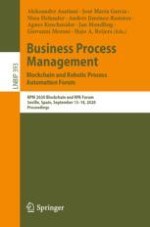This book constitutes the proceedings of the Blockchain and Robotic Process Automation (RPA) Forum which was held as part of the 18th International Conference on Business Process Management, BPM 2020. The conference was planned to take place in Seville, Spain, in September 2020. Due to the COVID-19 pandemic the conference took place virtually.
The Blockchain Forum and the RPA Forum have in common that they are centered around an emerging and exciting technology. The blockchain is a sophisticated distributed ledger technology, while RPA software allows for mimicking human, repetitive actions. Each of these have the potential to fundamentally change how business processes are being orchestrated and executed in practice. The BPM community has embraced these technologies as objects of analysis, design, development, and evaluation.
The 14 full plus one short paper presented in this volume were carefully reviewed and selected from a total of 28 submissions.
